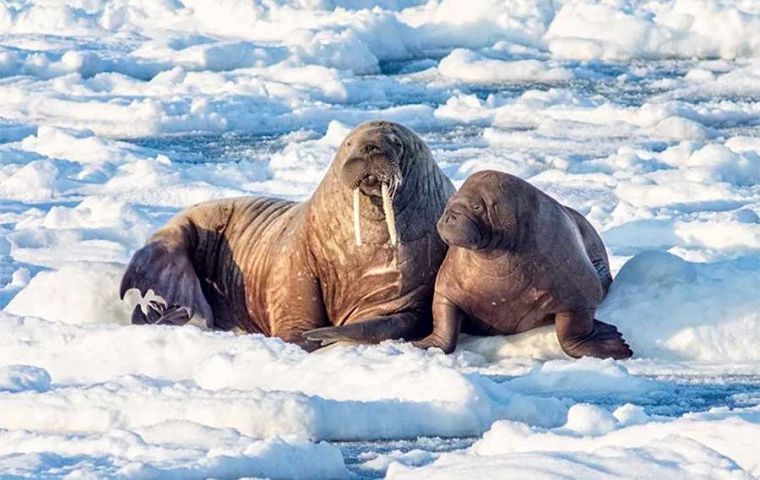MercoPress. South Atlantic News Agency
Sunday was World Walrus Day, with some 25,000 along the Atlantic
 Reaching more than 3m long and weighing over a ton, walruses regularly spend most of their time on sea ice. They need ice to breed and to rest
Reaching more than 3m long and weighing over a ton, walruses regularly spend most of their time on sea ice. They need ice to breed and to rest From their unmistakable tusks to their characteristic bristles (the envy of many a ‘Movember’ moustache!), the walrus is one of the Arctic’s most iconic species, and today (Sunday 24 November) is World Walrus Day!
There are two main subspecies of walrus, Atlantic and Pacific, with an estimated 25,000 Atlantic walruses in the wild. Reaching more than 3m long and weighing over a ton, walruses regularly spend most of their time on sea ice. They need ice to breed and to rest when they’re not out feeding.
But with the Arctic warming nearly four times faster than the rest of the world, sea ice is dramatically shrinking, and walrus are gathering in larger and larger numbers (and more often) on Arctic beaches and shorelines. With their large size and increasingly large gatherings, they can trample one another in a stampede to the sea.
British Antarctic Survey (BAS) and WWF are using satellite imagery to identify where walrus rest in the summer months to see how they may be affected by the climate crisis as a part of their six-year Walrus from Space project.
Dr Peter Fretwell, who researches animals from space at British Antarctic Survey, says: “Walruses are fantastic and charismatic creatures, unique to the Arctic. They prefer to come ashore in remote locations far to the North where people are few and traditional survey is difficult. But remoteness is no problem for satellites and when they haul-out on land they often do so in large numbers, with groups hundreds or thousands strong, which makes them ideal subjects for monitoring from space.”
Over 37,000 people from all over the world have already become ‘Walrus Detectives’, searching for walrus in satellite images to support BAS and WWF with the research project.
Rod Downie, Chief Advisor, Polar and Oceans, for WWF-UK said: “Walrus are an iconic species of the Arctic. They play a key role in the marine ecosystem and, for people living in the Arctic; they are of immense cultural significance.”
“But we can see their world shrinking under the pressure of climate change as the sea ice melts underneath them. With Walrus from Space, we’re trying to better understand walrus and how they’re responding to this crisis to support the conservation of the species.”
Find out how to become a walrus detective here: https://www.wwf.org.uk/learn/walrus-from-space



Top Comments
Disclaimer & comment rulesCommenting for this story is now closed.
If you have a Facebook account, become a fan and comment on our Facebook Page!